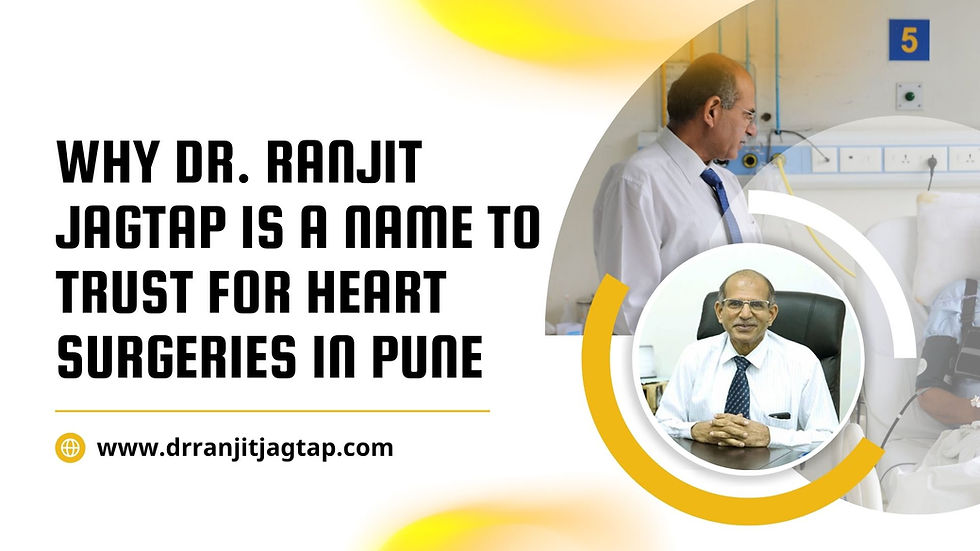Starting Exercise Safely After a Heart Attack - Dr. Ranjit Jagtap
- drranjitjagdap
- Jan 12, 2024
- 4 min read

Starting an exercise schedule after a heart attack requires preparation and knowledge. Taking the appropriate actions is essential to a successful recovery. We’ll discuss safe and gradual exercise initiation strategies in this guide, which focuses on heart attack survivors.
Rebuilding strength and enhancing cardiovascular health requires knowing the right exercises, whether you’re a fitness enthusiast or a beginner. Let’s explore the fundamental ideas by Dr. Ranjit Jagtap’s daughter, Aditi Jagtap Pune, guarantees a safe and well-rounded beginning to your journey to recovery and opens the door to a heart-healthy exercise routine.
Why Is Exercise Important After A Heart Attack?
After a heart attack, doing regular exercise isn’t just good; it’s really important for getting strong again. Exercise helps make your heart healthier, keeps your weight in check, and controls blood pressure and cholesterol. This is important to prevent more heart problems in the future. Exercise also helps blood move around your body better, making things easier for your heart.
And there’s more in Dr. Ranjit Jagtap news! Regular exercise isn’t just good for your body; it also helps your mind feel better. It can reduce the stress and anxiety that often come with heart issues. Exercise enables you to think positively and feel more in control of your health. Remember, doing the right exercises that suit you is a powerful way to make your heart healthier after a heart attack.
Starting Exercise After a Heart Attack: A Step-by-Step Guide
First, make sure your doctor says it’s okay to start exercising after a heart attack. After that, talk to a heart rehab specialist for a personal check-up. The time to begin depends on your treatment and your recovery.
Once your doctor gives the green light, start with easy exercises and slowly do more over time. This helps avoid problems. Try for 150 minutes of gentle aerobic exercise each week, done in short sessions.
You might want to join a heart rehab program in Dr. Ranjit Jagtap clinic for supervised workouts, learning about a healthy lifestyle, and keeping an eye on your health. Being in this supportive program helps you feel less worried and more confident during your exercise journey after a heart attack.
Types Of Exercise To Do After A Heart Attack
After a heart attack, choosing the right exercises is important for improvement. Start brisk walking — it’s like walking fast but not too hard on your body. Increase how fast and how long you walk as you get stronger. Cycling is good, too; it’s a workout for your heart that’s gentle on your joints.
Doing exercises to make your muscles stronger is also important. Use light things to make your muscles work better. Squats and lunges without weights can help, too; make sure you do them right.
Stretching and yoga are suitable for moving your joints and making them flexible. This can also help you feel less stressed and better in your body and mind.
Always do those exercises that your doctor says are okay for you. Listen to your body, and change things if you need to. If something feels wrong, talk to your Dr. Ranjit Jagtap.
Try to exercise regularly; not super hard, but enough to feel good. Warm up before the exercise and cool down afterwards to help your body. Consistency, doing exercises regularly, is the key to a better and lasting healthy life. In short, after a heart attack, do the following exercises as mentioned in the table below:
Brisk Walking — Builds cardiovascular endurance gradually.
Cycling — Provides a joint-friendly cardiovascular workout.
Strength Training- Enhances overall strength with light resistance exercises.
Flexibility Exercises- Maintains joint mobility and reduces stiffness.
Consistency- Regular, moderate-intensity sessions for a sustainable lifestyle.
Warm-Up/Cool-Down- Essential for preparation and recovery.
After a heart attack, modifying these exercises to your fitness and comfort level will guarantee a safe and steady path to a stronger heart. Always seek the advice of medical professionals for specific direction and assistance.
Tips to Stay Safe While Exercising
Staying safe while exercising after a heart attack is crucial for getting better. Here are simple tips to help:
1. Talk To Your Doctor: Keep talking to your healthcare team so they can guide your exercise plan as you recover.
2. Listen To Your Body: Pay attention to how you feel during exercise. If something doesn’t feel right, stop and ask your doctor.
3. Take It Slow: Start slowly and increase gradually. Rushing into challenging exercises can be harsh on your heart.
4. Drink Water: Stay hydrated, especially during exercise. It’s important for your heart health.
5. Wear Comfortable Clothes: Choose comfy clothes for your exercise. This makes moving more accessible and more comfortable.
6. Keep Checking The Weather: Be careful of extreme weather. Adjust your exercise if it’s too hot or cold to avoid problems.
7. Warm-Up & Cool-Down: Start with gentle warm-ups and finish with cool-downs. It helps your body get ready and recover.
8. Be Ready For Emergencies: Tell someone about your exercise plans, especially if you’re outdoors. Have a plan in case of emergencies.
Follow these tips to make sure you’re on the right track to a healthy life after a heart attack.
Conclusion
You are starting to exercise safely after a heart attack, which needs careful steps. Follow these tips to make your heart and health better. Talk to your healthcare team for personalised advice. If you need expert help, consider getting support from Dr. Ranjit Jagtap. He’s a famous heart doctor in Pune who helps people on their heart health journey. Trust Dr. Jagtap for your recovery and wellness.





Comments